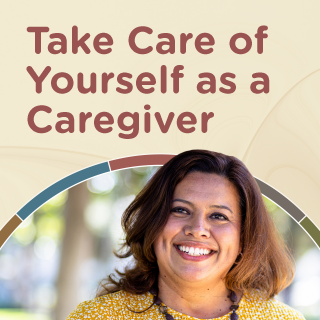Sharing Caregiving Responsibilities
On this page:
Caring for an older person often requires teamwork with family, friends, or formal caregivers. While a person who lives nearby might take on most of the everyday responsibilities, people who live farther away can also play an important role in coordinating care. Explore this page for tips on how best to share caregiving tasks.
How to get started
Splitting caregiving responsibilities is a multistep process. Caregivers will need to figure out what care is needed, choose a primary caregiver, and decide who will be responsible for which tasks.
Identify the care needs
First, work as a team to figure out what the caregiving responsibilities will be. You could start by setting up a meeting or conference call with the older person and everyone who will be involved in their care. This conversation will be most productive when there is not an emergency. A calm discussion about what kind of care is wanted and needed in the present, and what might be needed in the future, can prevent confusion and misunderstanding later.
Choose a primary caregiver
When several people are involved in caregiving, many find that the best first step is to name a primary caregiver. This is the person who takes on most of the everyday caregiving responsibilities. Even if a primary caregiver is not needed immediately, identifying someone now will allow that person to step in right away if there is a crisis.
Determine how each caregiver will contribute
The next step is to decide who will be responsible for which tasks. Ideally, each person providing care will be able to take on the tasks best suited to their skills and interests. When thinking about everyone’s strengths, consider what each person is particularly good at and how those skills might help in the current situation.
-

The Caregiver's Handbook
Explore this guide to getting started with caregiving, finding support, and taking care of yourself.
Splitting up caregiving tasks
When deciding how to share caregiving responsibilities, consider these questions:
- Who is best at finding information and keeping people up to date on changing conditions?
- Who is most comfortable using email, text messages, and other forms of technology?
- Who do people call when they need emotional support and someone to talk to?
- Who is most confident about speaking with medical staff and conveying information to others?
- Who lives close enough to assist with day-to-day tasks, such as grocery shopping, cooking, and cleaning?
- Who likes coordinating larger tasks, such as helping to organize a move?
- Who is good with numbers? Could they take charge of tasks such as paying bills, keeping track of bank statements, and reviewing insurance policies and reimbursement reports?
- Other than the primary caregiver, who can step in to help occasionally? For example, can someone stay with the person needing care so the primary caregiver can take a short break or go on vacation?
Over time, these decisions may need to be revised. There can be changes in the needs of the person receiving care and in family members’ availability. Check in with the older person and the other caregivers regularly to make sure the current arrangement is still working for everyone. Update the plan for sharing tasks as circumstances change.
Use NIA’s Worksheet: Coordinating Caregiving Responsibilities (PDF, 161K) to help you have a productive conversation about identifying and sharing caregiving tasks.
-
Stay in the know with a caregiving notebook
To keep everyone involved in caregiving informed, it may be useful to compile a notebook with details about the care recipient’s medical care, social services, contact numbers, financial information, and other pertinent details. This list can be created and updated electronically or in a paper notebook that’s kept in a central location. There are also smartphone apps that enable you to divide up caregiving duties, keep an appointment calendar, and share updates with others. Whichever format you choose, make sure everyone has access to the caregiving notebook and that it is reviewed regularly and updated as needed.
Knowing your limits
No one can be expected to do everything. Be gentle with yourself and realistic about how much you can do and what you are willing to do. For example, you might ask yourself:
- How will my decision to take on caregiving responsibilities affect my work and home life?
- If I don’t live nearby, how often, both mentally and financially, can I afford to travel?
- Am I emotionally prepared to take on what may feel like a reversal of roles between me and the older person — such as taking care of my parent instead of my parent taking care of me? Can I continue to respect their independence?
- Can I be calm and assertive when communicating with the older person and any other caregivers? Could I seek advice or training to get better at this?
-
Caregiving and the sandwich generation
About one in four caregivers care for their children as well as an aging parent or partner. These caregivers are referred to as the “sandwich generation.” Sandwich generation caregivers may face additional emotional and financial challenges in caring for both children and parents. If you are a sandwich caregiver, consider how you might ask for help from family and friends. Joining a support group to hear from others in your position may also be helpful.
Supporting a primary caregiver
In many cases, one person takes on most of the everyday responsibilities of caring for an older person. It tends to be a spouse or the child or sibling who lives closest. If you are not the primary caregiver, you can still play an important role in supporting that person.
A primary caregiver — especially a spouse or partner — may be hesitant to ask for help or a break. Maybe you can plan to visit on a regular basis so the primary caregiver can have some personal time. Or perhaps you can arrange for regular respite care in the form of a volunteer, an in-home aide, or an adult day care program. Read more about ways to support a primary caregiver.
Many people live far away from family or friends who may need help. Long-distance caregivers can help by providing emotional support to the primary caregiver and coordinating certain aspects of care from afar. Find more information about long-distance caregiving , including how you can help, ways to stay in touch, and resources for caregivers who live far away.
You may also be interested in
- Learning about getting started with caregiving
- Finding answers to frequently asked questions about caregiving
- Downloading or sharing an infographic with tips for taking care of yourself as a caregiver
Signup for E-alerts about caregiving tips and resources
For more information about caregiving
Eldercare Locator
800-677-1116
eldercarelocator@USAging.org
https://eldercare.acl.gov
ARCH National Respite Network and Resource Center
703-256-2084
www.archrespite.org/
Well Spouse Association
800-838-0879
info@wellspouse.org
www.wellspouse.org
Caregiver Action Network
202-454-3970
info@caregiveraction.org
www.caregiveraction.org
Family Caregiver Alliance
800-445-8106
info@caregiver.org
www.caregiver.org
This content is provided by the NIH National Institute on Aging (NIA). NIA scientists and other experts review this content to ensure it is accurate and up to date.
Content reviewed:
October 12, 2023




